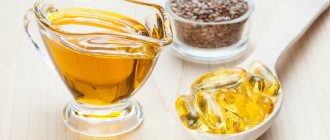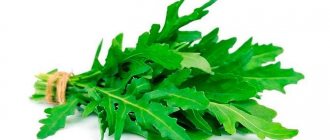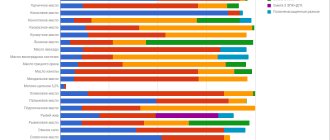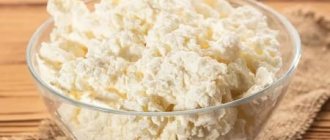After many years of oblivion and persecution, nutritionists have finally rehabilitated fats. And now those who are losing weight and adherents of a healthy diet have a new task - to choose from the fatty variety exactly what will bring the greatest benefit. Today in our ring we find fish oil and flaxseed oil - two sources of Omega-3 fatty acids, which are essential and necessary for our body, like air.
Which is better - fish oil or flaxseed oil? Let's try to answer this question!
A little science
Omega-3 fatty acids come in different types. The most famous and widespread are
- eicosapentaenoic acid or EPA;
- docosahexaenoic acid or DHA;
- alpha-linolenic acid or ALA.
The first two are found in animal products, the latter in plant foods. DHA and EPA are absorbed almost 100% and serve as direct building materials for cell membranes, are required for the proper functioning of all body systems and are necessary for healthy growth in children.
ALA, although it belongs to Omega-3, cannot be used in its original form - the human body processes it into DHA and EPA, already known to us. True, with critically low efficiency - only 5-6%.
Round #1 Benefit
Which is better - fish oil or flaxseed oil in terms of Omega-3 content? The human body cannot produce any of the above acids (EPA, DHA and ALA) on its own. So, taking any of these supplements will have a positive effect on your health in any case.
But if we move on to specific numbers:
- 100 grams of fish oil contains about 30 grams of EPA/DHA;
- 100 g of flaxseed oil contains about 70 g of ALA;
- If we take into account the acid conversion coefficient, it turns out that from 100 g of flaxseed oil a person receives only 4.2 g of fully digestible DHA/EPA, which is 7 times less than the amount of acids obtained from fish.
Fish oil wins this round in his favor!
Round #3 Harm
If you are faced with a dilemma about what is better to choose, flaxseed oil or fish oil, then pay attention to the presence of harmful substances in the product. Flaxseed oil contains large amounts of phytoestrogens, which can be dangerous for people with thyroid disease.
But liquid fish oil often contains mercury and other heavy metals, which tend to accumulate in the body and can lead to disastrous consequences.
So in this round, flaxseed oil comes out on top again - 2:1 in its favor!
Reminder to the buyer
If, after reading this article, you decide to buy Omega-3, then only now, using the promotional code OMEGA-3, you can get a 10% discount on any Omega-3 in the Phytomarket. Just follow the link, activate the promotional code, add items to your cart and complete your purchase.
TO THE CATALOG
BUY OMEGA-3
Round No. 4 Compensating Omega-6 acids
In addition to the well-known Omega-3 acids, the human body also needs Omega-6 acids. However, both of these components must be in balance - for 1 part Omega-3 we need 2 parts Omega-6.
However, the diet of a modern person is catastrophically unbalanced, so the average urban resident consumes about 30 parts of Omega-6 for only 1 part of Omega-3. Which is fraught with thrombosis, heart attacks, strokes, and increases the risk of inflammatory diseases and disorders of the cardiovascular system.
Now let's look at the chemical composition of fish oil and flaxseed oil.
| Linseed oil | Fish fat | |
| Omega-3 | 61% | 30% |
| Omega-6 | 30% | 5% |
What do we end up with? Together with fish oil, a person receives 6 parts of Omega-3 and one part of Omega-6. But flaxseed oil contains only 2 servings of Omega-3 per serving of Omega-6.
Considering that we get Omega-6 from hundreds of other foods - vegetable oils, poultry, plant foods, beans and nuts, and healthy Omega-3 cannot be found anywhere else, then the winner of this round is fish oil!
The overall score is 2:2 and a draw again!
Flax oil and fish oil: comparing properties
Fish oil or flaxseed oil - both components are sources of essential Omega acids. And this is the only thing that unites them. Otherwise, the additives have different characteristics (see table).
Table. Fish oil and flaxseed oil - comparison
| Category | Fish fat | Linseed oil |
| Omega-3 content (Ω-3), g | 13.4 (herring), 19.7 (cod liver) | 53 |
| Benefit | Prevents a number of diseases of the cardiovascular system. It is used for medical purposes for anemia, rickets and for recovery after serious illnesses. Increases serotonin levels. Improves the functioning of the gastrointestinal tract. Lowers cholesterol levels. | Normalizes digestion. Prescribed for inflammation of the oral cavity, diseases of the cardiovascular system, liver and gastritis. It is used for figure correction and in home cosmetology. It alleviates the consequences of burns, has regenerative properties, and treats joint diseases. |
| Omega-6 content, g | 1.15 (in herring) 0.93 (in cod liver) | 17 |
| Balance Omega-3:Omega-6 | 1:0.09 (in herring) 1:0.05 (in cod liver) | 1:0,3 |
| Composition of other nutritional components | Vitamins A and D, as well as iodine, sulfur, bromine, phosphorus (in minimal quantities) | Vitamin E (tocopherol), lignans, folic acid (B9) |
| Absorption by the body Ω-3, g | 8,3 | 3 |
Important information! The ideal balance of Omega-3 to Omega-6 is 1 to 3.
How was the degree of assimilation calculated? Let's look at the formula in detail. Omega-3 is made up of 3 essential fatty acids (FAs):
- docosahexaenoic acid - DKG or DHA;
- alpha-linoleic - ALA or ALA;
- ecosapentaenoic acid - EPA or EPA.
When reading the composition of flax seed oil (linseed oil), you will find the ALA content. This acid is converted into DKG and EPA by the body independently. EPA/DKG is observed in marine fat (fish oil).
What difference does it make what kind of LCD we will receive? ALA is synthesized exactly into DHA and EPA. The fact is that alpha-linoleic acid is converted into ecosapentaenoic and docosahexaenoic acids with a reduced concentration. This fact is proven by the following data:
- 100 g fat = 25 g (approximately) DKG + EPA.
- 100 ml oil = 60 g (average amount) ALA.
- Reduction factor for ALA synthesis in DCG and EPA = 5% (approximately).
The initial values are known, let's move on to the calculations:
- Omega-3 digestibility due to oil. 60 g (ALA) * 5% (ratio) = 3 g.
- Digestibility of Ω-3 due to consumption of fish oil. 25 g (DHA/EPA) / 3 g = 8.3 g.
We get a comparison of FA absorption by the body:
- Linseed oil – 3 g.
- Fish oil - 8.3 g.
Flax oil contains more Omega-3. However, due to the low concentration of conversion of ALA to DHA/EPA, we get more omega nutrients from fish oil.
Which is better, fish oil or flaxseed oil - the answer is not clear. Both products are first-class sources of essential fatty acids. It’s just that to saturate the body with Ω-3, more vegetable extraction will be required.
On a note! Flaxseed oil is widely used in cooking. Season salads with it, add it to baked goods, etc. Healthy food is the best way to get vitamins.
Products have contraindications! Get advice from a specialist and read the instructions carefully!
Round No. 5 Benefits for children
Fish oil is a constant childhood companion for those who were lucky enough to be born before the 90s. Why is it so important for children to take this supplement?
- It ensures proper skeletal growth through vitamin D;
- reduces the risk of diabetes and obesity;
- the vitamin A it contains is essential for eye health;
- Omega-3 increases attention and concentration, helps to quickly absorb new knowledge;
- reduces the risk of rickets.
But flaxseed oil, which is fashionable today, was previously used exclusively as... an antiparasitic agent.
Today, both fish oil and flaxseed oil can successfully replace properly selected vitamin and mineral complexes.
But if you still want to give your child additional Omega-3 acids, then opt for children's chewable capsules - they are free of heavy metals, enriched with vitamin D and calcium, and also have a pleasant sweet taste and resemble gelatin bears.
What is better for a child - fish oil or flaxseed oil? Our favorite in this round is fish oil .
TOP 5 vitamin complexes
Fish oil and flaxseed oil are not drugs. High-quality preparations with fish oil and flaxseed oil are produced mainly in capsules. There are many dietary supplements with Ω-3 sources in combination on the health product market. To make choosing a supplement easier, a selection of the TOP 5 according to VITGID will help.
Women Sense by Natural Factors
Natural Factors, WomenSense, RxOmega-3, 120 Enteripure Softgels
857 rub.
More details
Production: North America.
The drug is available in gel capsules, 120 pcs. Contains a complex of organic acids: EPA, DHA, ALA, GLA. Two capsules per day can cover the daily requirement of PUFAs.
76% of consumers rate the product 5 stars, and only a small portion (4%) did not notice the effect.
Omega 3-6-9, 1300 mg from Solgar
Solgar, Omega 3-6-9, 1300 mg, 120 Softgels
RUB 2,166
More details
Production: USA.
Available in soft tablets, 120 pieces. Contains equal amounts (1.3 g) of Buranchik and flaxseed oils + fish oil. The daily portion consists of 3 capsules.
Most buyers note the effectiveness of the drug. No significant disadvantages were found.
Fish, Flax, Borage, 1200 mg from Nature's Bounty
Nature's Bounty, Fish, Flax, Borage, 1200 mg, 72 Fast Release Softgels
978 rub.
More details
Country: USA.
Available in quick-release soft tablets. The package includes 72 capsules, which equals 24 servings. The optimal daily dose is 3 tablets. The composition includes Omega 3-6-9 complex in the amount of 3.6 g per serving. Main components: fish oil, flax and buranchik oils.
According to reviews, no negative effects from taking the drug were found. While most buyers consider it effective.
Omega 3-6-9 – Fish, Flax, Borage from Sundown Naturals
Sundown Naturals, Omega 3-6-9 - Flaxseed Oil, Fish Oil & Borage Oil, 200 Softgels
RUB 2,144
More details
Manufacturer: USA.
Produced in soft capsules, in quantities of 200 pieces. This is exactly 66 servings, based on 3 tablets. per day. The drug is saturated with fish oil, flax oil and buranchik.
Buyers like the volume of packaging, reasonable price and high quality of the product. A minimum of consumers did not notice the effect.
21st Century Triple Omega Complex 3-6-9
21st Century, Triple Omega Complex 3-6-9, 180 Enteric-Coated Softgels
RUB 1,132
More details
Country: USA.
The packaging includes 180 and 90 enteric-coated gelatin capsules. The drug is taken 1 tablet three times a day with meals. Each capsule contains 1 g of vital omega acids.
Consumers highlight a number of advantages: economical packaging, natural composition, comfortable reception and high quality.
Scoring
What do we end up with? Fish oil wins this battle by a small margin . But this does not mean that flaxseed oil is a bad source of Omega-3 acids. Rather, it should not be the only thing in your diet.
Flaxseed oil and fish oil can be consumed simultaneously , since an overdose of Omega-3 acids is a very rare occurrence.
If you need to take Omega-3 polyunsaturated fatty acids for the treatment or prevention of certain diseases, then preference should be given to capsules. They are easier to carry, do not lose their properties over time, are neutral or even pleasant to taste, have a higher concentration of Omega-3 and are purified from harmful compounds.
Stay healthy and enrich your diet with healthy products with the Biofam healthy goods supermarket!
Plant foods high in Omega 3
We present to your attention a small list of plant-based products high in Omega 3.
It is important to note that self-medication can negatively affect your health, so if you have any health problems, you should first contact a medical specialist.
Linseed oil
Flaxseeds contain a real storehouse of fatty acids that we all need to stay healthy and active. Flaxseed oil, accordingly, is also rich in a high content of healthy fatty acids, including Omega 3 - per 100 g of oil there are up to 60 g of PUFAs.
In addition, oil is much more pleasant to eat than seeds. Therefore, people who care about their health and beauty often include flaxseed oil in their diet. It is great for preparing salad dressings, and can also be an addition to ready-made main courses.
Possible alternative: Biafishenol fish oil with flax oil
Olive oil
The Omega 3 content in olive oil is 7 g per 100 g of oil, which is much inferior to flaxseed oil. But at the same time, olive oil is very easily digestible. For people who have problems with their intestines and stomach, nutritionists often recommend adding olive oil to their diet in order to normalize their function. It can be used as a salad dressing, an addition to main courses, and also for frying during cooking.
Algae oil
Studies have shown that algae are very rich in Omega 3 acid. Moreover, its content can be increased by regulating the algae's exposure to oxygen and ultraviolet radiation, temperature, glucose, and sodium. That is why, in modern conditions, the direction of cultivating these marine organisms in laboratory conditions is actively developing. In this way, it is possible to increase the Omega 3 content in them.
Moreover, there are special technologies using which oil is extracted from seaweed. It undergoes purification and can then be used to produce vitamins and supplements. Algae oil is included in various foods and even baby formulas. It is also important that in terms of its nutritional value, algae oil is comparable to fish oil.
Possible alternative: Fish oil "Biafishenol" with kelp
Other oils
Not all vegetable oils are high in fatty acids. For example, the Omega 3 content in sunflower, palm and cottonseed oil is only 0.2 g per 100 g of oil. Let us note oils in which the Omega 3 content is quite high:
- camelina oil - 38 g;
- hemp - 19 g;
- cedar - 20 g;
- walnut oil - 10.5 g;
- avocado oil - 9.6 g;
- rapeseed - 10 g;
- soybean - 7 g;
- mustard - 14 g.
Including these oils in your diet will also help provide the body with the necessary amount of unsaturated fatty acids and other important microelements. However, if you experience any discomfort or pain, do not try to “treat” it with oils; it is better to consult with a specialist without delaying it.
Omega 3 for Vegans
As already mentioned, algae and other seafood are famous for their high Omega 3 content, primarily fatty fish, as well as beef, eggs and other animal products. However, this “grocery set” is not suitable for everyone. People who deliberately refuse to eat animal foods run the risk of causing a lack of polyunsaturated fatty acids in the body. To avoid this, it is recommended to include the following vegan sources of Omega 3 in your diet:
- vegetable oils high in Omega 3 (the already mentioned flaxseed oil, hemp oil, cedar oil, walnut oil, olive oil, mustard oil, algae oil);
- chia seeds;
- seaweed;
- pumpkin;
- greens and vegetables (spinach, cauliflower, broccoli, Brussels sprouts);
- berries (blueberries, grapes, but not grape seed oil, it has very low Omega 3 content);
- wild rice;
- spices and herbs (cloves, oregano, marjoram, tarragon);
- mango;
- melon.
If difficulties arise with some products due to their seasonality or high cost, then Biafishenol preparations, presented in a wide range, come to the rescue. After consulting with your doctor, you can choose a drug that best suits your body's needs.











